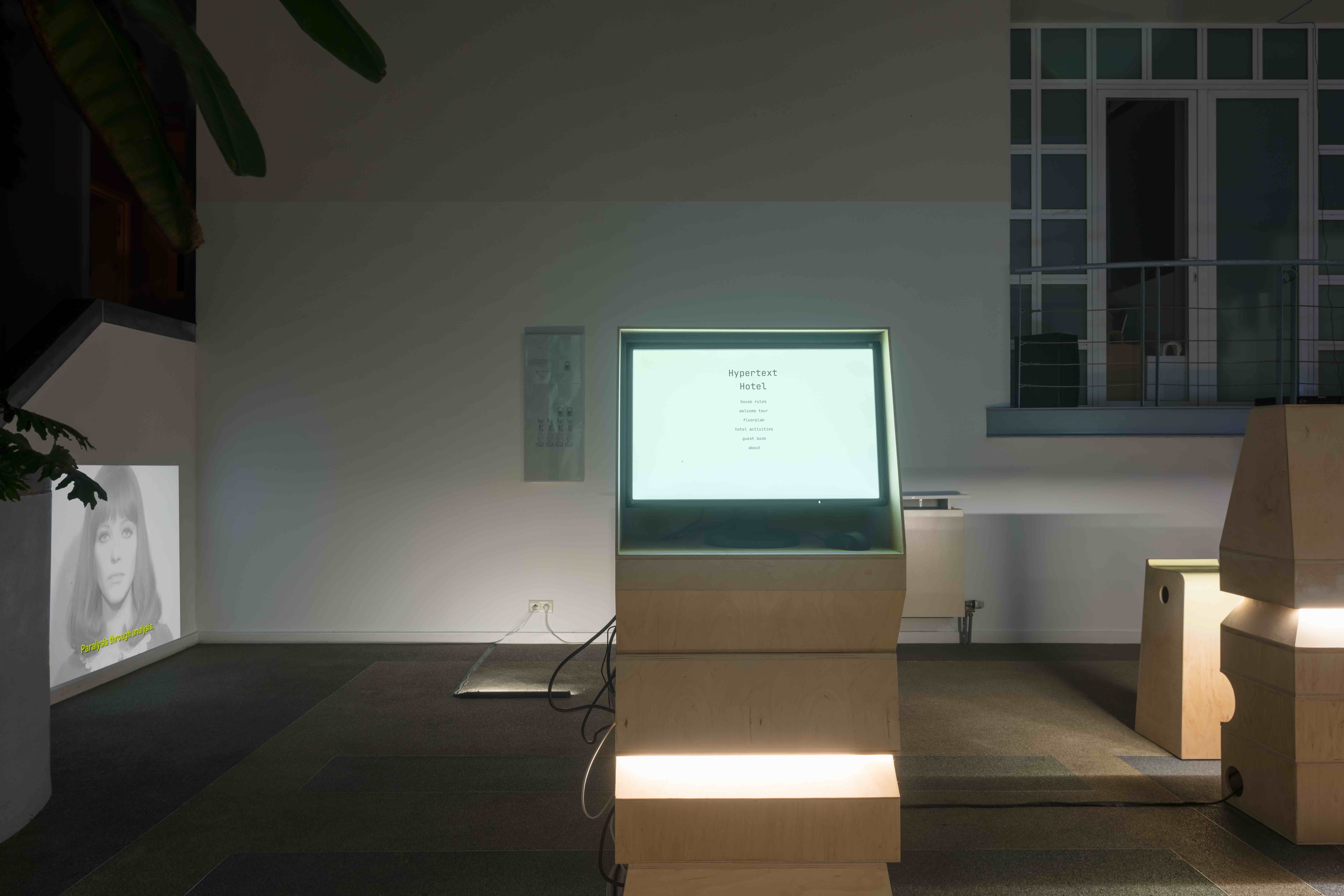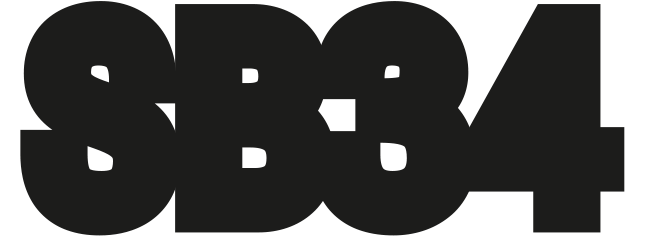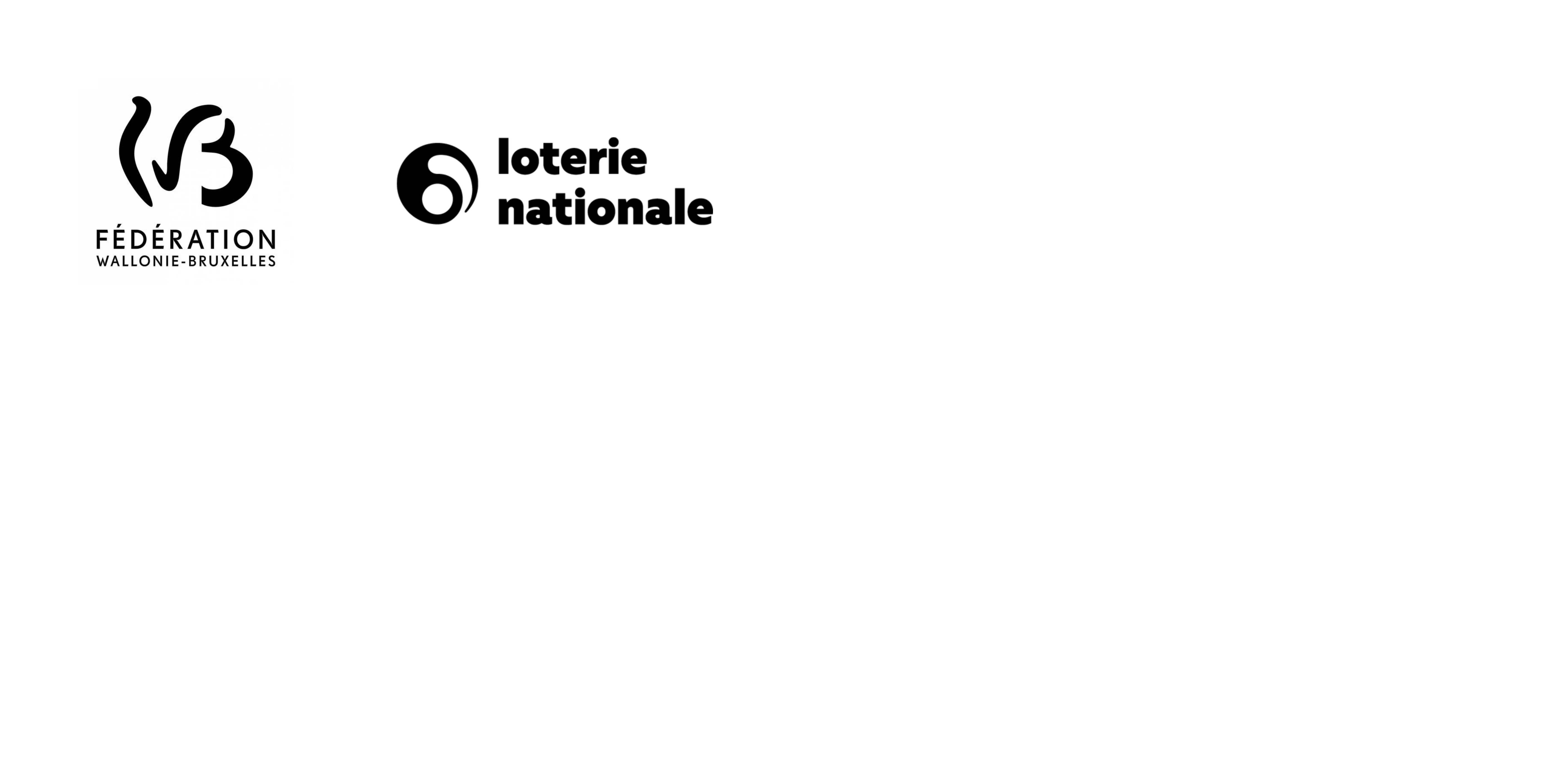
Hypertext Hotel is a network of rooms and passages, a collective endeavour, a co-authored text, an appropriated myth, a place of secrets and transgressions, a narrative structure, a mood, a premise for an exhibition.
The project borrows its title from a virtual space for collaborative writing set up by Robert Coover in 1991 for his workshop at Brown University, and it takes the then-emerging genre of ‘hypertext fiction’ – one of the earliest examples of electronic literature – as a starting point to think of an exhibition as a collective work of interactive fiction, where different scenarios and readings are not only permissible but inevitable.
Curated by Alicja Melzacka
︎ HYPERTEXT HOTEL
Hypertext Hotel is a network of rooms and passages, a collective endeavour, a co-authored text, an appropriated myth, a place of secrets and transgressions, a narrative structure, a mood, a premise
The project borrows its title from a virtual space for collaborative writing set up by Robert Coover in 1991 for his workshop at Brown University, and it takes the then-emerging genre of ‘hypertext fiction’ – one of the earliest examples of electronic literature – as a starting point to think of an exhibition as a collective work of interactive fiction, where different scenarios and readings are not only permissible but inevitable.
The ambition to do away with narrative linearity goes back to the pre-digital literary experiments, but it was hypertext fiction that first dared to abandon the old medium and harness the potential of the nascent computer technology to that end. The collaborative, do-it-yourself attitude of those involved translated into hypertext fiction’s characteristic rudimentary visuals, and the post-cold-war techno-optimism into its unique emotive quality. These values and aesthetics are now looked back at with a mixture of condescension and desire.
Hypertext Hotel also taps into the hotel’s reputation as a site of secrets and transgressions, which has been established in film and literature, especially in the (neo-)noir genre. While these two genres might appear dissimilar, hypertext fiction being a digital native forking its way out of linear storytelling and noir – a pulp paperback following a tried-and-true narrative arc, they meet somewhere in the vaporwave rooms of cyber-hotels.
For the duration of the project, the delightfully postmodern interior of Clovislaan 87 will be transformed into the lobby of Hypertext Hotel. From there, the visitors can access the physical and digital infrastructures and explore the works of the hotel residents: Henry Andersen, Kendal Beynon, Bartek Buczek, Shelley Jackson, Daniel Jacoby, Peter Lemmens, Stuart Moulthrop, and Alicja Melzacka.
The heterogeneous body of the exhibition is held together by the soft tissue of hypertext fiction, which was co-written on this occasion, and which invites interaction from the visitors.
Alicja Melzacka


















(c) Silvia Cappellari
︎ HOTEL ACTIVITIES
Friday, 25.11.2022 — Grand Opening
Thursday, 08.12.2022 – Hypertext Reading Group
Saturday, 14.01.2023 – VaporWavePool Sound Session
︎ LIST OF WORKS
︎ Henry Andersen, A partial timeline of computer viruses in the twentieth-century, 2022
Silkscreen and plastic transfer sheets on found metal shelving
︎ Henry Andersen,The parallel between the body and computers is thus established, 2022
Silkscreen and plastic transfer sheets on found metal shelving
︎ Henry Andersen, How to have a body in an epidemic, 2022
Silkscreen and plastic transfer sheets on found metal shelving
︎ Kendal Beynon & Alicja Melzacka, Hypertext Hotel, 2022
Cyber-infrastructure, on the terminal
︎ Kendal Beynon, Peter Lemmens & Alicja Melzacka, Welcome Tour, 2022
Electronic exhibition text, on the terminal
︎ Bartek Buczek, Terminals, 2022
Polywood, lacquer, LED lights
︎ Bartek Buczek, Motorcycle, 2022
Polywood, glue, lacquer
︎ Shelley Jackson, Patchwork Girl, 1995
Electronic fiction, published by Eastgate Systems, on the terminal
︎ Daniel Jacoby, Ahold of Get the Things To, 2014
Film, 17’, 6mm transferred to digital file, sound
︎ Peter Lemmens, reverse engineering, 2020-2021
Film, 1’39’’, 16:9, digital file, sound
︎ Peter Lemmens,variant futures redux (B.R. edit), 2022
Film, ’51’’,16:9, 1 digital file, sound,on the terminal
︎ Peter Lemmens, burn-in screen (subtitles), 2022
Glow-in-the dark paint
︎ Stuart Moulthrop, Deep Surface, 2007
Multimedia cybertext, sound
︎ HOTEL RESIDENTS
HENRY ANDERSEN studied as a composer of experimental music in Perth and Berlin before moving to Brussels and retraining as a visual artist. He makes performances, sculpture, sound recordings and printed matter, sometimes alone and sometimes in collaboration with Bryana Fritz as part of Slow Reading Club. Henry develops techniques for producing and altering text according to various scores, constraints and manual processes. Elsewhere, he uses logics of writing, editing and reading to make visual works. Much of Henry’s work borrows strategies from publication and is informed by a sustained interest in ways that existing cultural objects are kept in circulation: bootlegs, cover versions, samples, translations, fan fictions etc.
KENDAL BEYNON is a UK-born artist & writer currently situated in the realm of experimental publishing in Rotterdam, NL. She aims to rediscover an alternative online landscape through subversive design and community building, while also examining the ruins of our digital past. Highly skilled in editing through a Journalism degree in the UK and existing in the art publishing world since 2015. Kendal studied music journalism and graphic design, and in 2022, she received her MA degree in Experimental Publishing from Piet Zwart (thesis: Cyberhotels and Other Tales of Forgotten Virtual Worlds).
BARTEK BUCZEK is an artist and a co-founder of Galeria Technik – a Krakow-based collective of art handlers, technicians, and exhibition designers, offering a wide range of skills in the field of art production and presentation. Early in his career, he considered himself one of the most talented painters of his generation. Since 2020, he has been making exclusively panegyric works dedicated to his favourite tools. In his practice, Buczek looks for a creative element in professional relations with his clients. Aside from assisting artists and institutions with the execution of their projects, he makes visible the work behind any artistic production and draws attention to the material dimension of art.
SHELLEY JACKSON is an American writer and artist known for her cross-genre experimental works. She earned a B.A. in art from Stanford University and an MFA in creative writing from Brown University. Jackson established her reputation as a literary author by writing the early hypertext fiction A Patchwork Girl (1993) and has continued to work in multiple media; her story SKIN, for example, was tattooed on volunteers' bodies (2003). She has also published a print novel, Half-Life, and a short story collection, The Melancholy of Anatomy. Jackson teaches in the graduate writing program at The New School in New York City and the European Graduate School in Saas-Fee Switzerland, where she is a writer-in-residence.
DANIEL JACOBY is a Peruvian visual artist and filmmaker based in the Netherlands. His interest in the human condition has led him to eccentric characters, places and stories, which he strives to approach from inventively tangential points of view. With a recurring use of abstraction, the result tends to be a personal and subjective exploration of topics like outsiderness, belonging, loneliness, friendship and desire. His work has been part of exhibitions at EYE Filmmuseum (Amsterdam), Fundació Joan Miró (Barcelona), Delfina Foundation (London), The Banff Centre (Alberta) and Palais de Tokyo (Paris).
PETER LEMMENS is an artist, who looks at operational levels for their social, political, economical and artistic capacities. At this intersection, he works on how to organize oneself responsibly, contaminating the question of “what to produce?” with the question of “how to produce?”. While working on distribution, narrativity, DIY and marginal practices, his works are demarcations not only of what can be done differently but of what can be done simultaneously. This carries a small but fundamental nuance. He thinks conflict and development is not about resolution, but a permanent, fragile mode of production. Sound, video and text are often used. He thinks amateurism is not incompetence. He likes to make boring works. He sees diversions as a productive method. His work formulates an exit strategy. Working with others is a constant in his practice and finishes this bio by quoting 'Mine is not an autonomous imagination’.
ALICJA MELZACKA lives in Maastricht and works in and between different places, often on the train. She is currently part of the team at Jester (f.k.a. CIAP and Flacc) in Genk. In 2019, she completed a postgraduate in Curatorial Studies at KASK, Gent. Before that, she studied art history and heritage studies (at Gdansk University and Maastricht University, respectively), and she also had a thing for applied linguistics and translation. Language in its various forms and contexts, especially in relation to art and exhibition-making, continues to be her main interest. Her infatuation with hypertext fiction was the initial impulse behind this project.
STUART MOULTHROP is a U.S. academic active in electronic literature, game studies, and digital humanities since the late 1980s. He has published many works of computational writing, from Victory Garden in 1991 to Meccano No. 2 in 2022. His work has appeared in The Vassar Review, The Iowa Review Web, and New River. He was co-editor of the pioneering online journal Postmodern Culture from 1995-97 and edited its first issue of born-digital projects. He is co-author of two scholarly books, Traversals: The Uses of Preservation for Early Electronic Writing, with Dene Grigar (2017, MIT Press), and Twining: Critical and Creative Perspectives on Hypertext Narratives, with Anastasia Salter (2021, Amherst College Press). He was a founding board member of the Electronic Literature Organization in 1999. Moulthrop is Distinguished Professor of English at the University of Wisconsin-Milwaukee, where with the anthropologist Thomas Malaby he co-directs the Digital Cultures Collaboratory in the Center for 21st Century Studies.
︎ Open on Sat. 16:00 - 20:00
With the kind supports of Fédération Wallonie-Bruxelles and Région Bruxelles-Capitale/Image de Bruxelles.
Many thanks to Joseph Knierzinger and Piet Zwart Institute; Paul Devens; Eastgate Systems Inc.; Jester, Genk; the Royal Academy of Fine Arts Antwerp.


